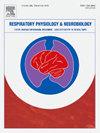Disordered tidal breathing pattern and dyspnoea related disability in Parkinson's disease: A case controlled study
IF 1.6
4区 医学
Q3 PHYSIOLOGY
引用次数: 0
Abstract
Background
Respiratory dysfunction is a recognised but underexplored feature of Parkinson’s Disease. Understanding underlying mechanisms and their possible impact on breathing patterns is crucial to endeavours to improve respiratory morbidity and mortality associated with Parkinson’s Disease.
Objective
This study explored perceived dyspnoea and resting tidal breathing patterns in Parkinson’s Disease compared to healthy controls.
Methods
Nineteen Parkinson’s Disease participants and 19 age and gender matched controls were recruited. Respiratory assessment included the modified Borg dyspnoea scale, modified Medical Research Council dyspnoea scale, and respiratory inductance plethysmography to measure inspiratory time, expiratory time, total cycle time, respiratory rate, I:E ratio, and thoracic excursion during tidal breathing.
Results
Parkinson’s Disease participants (Hoehn and Yahr stages 1–3; 10 men; 9 women, mean age 65 +/-8years; mean MDS-UPRRS 44.05 +/-18.9) reported significantly greater respiratory disability (modified Medical Research Council) compared to controls (p = 0.005). Dyspnoea rating (modified Borg dyspnoea scale) and disability was significantly greater in the Tremor Dominant group (p < 0.01). Notably, linear mixed models analysing change in breath regularity over time, identified a higher I:E ratio (p = 0.03) and ratio of inspiration to total cycle time (Ti/Ttot) in Parkinson’s Disease participants (p = 0.04), indicating an altered tidal breathing pattern. Thoracic excursion was lower in Parkinson’s Disease participants although differences were non-significant.
Conclusion
Individuals with Parkinson’s Disease experience functional disability related to dyspnoea and altered breathing patterns compared to controls. Further research is warranted with larger numbers to explore these findings across Parkinson’s Disease stages and motor subtypes to develop strategies to improve respiratory health in Parkinson’s Disease.
帕金森病潮汐呼吸模式紊乱和呼吸困难相关残疾:一项病例对照研究
背景:呼吸功能障碍是帕金森氏病公认但未被充分研究的特征。了解潜在的机制及其对呼吸模式的可能影响对于努力改善与帕金森病相关的呼吸系统发病率和死亡率至关重要。目的:本研究探讨帕金森病患者与健康对照者的感知呼吸困难和静息潮汐呼吸模式。方法:招募了19名帕金森病患者和19名年龄和性别匹配的对照组。呼吸评估包括改进的Borg呼吸困难量表、改进的医学研究委员会呼吸困难量表和呼吸感应体积脉搏图,以测量吸气时间、呼气时间、总周期时间、呼吸频率、I:E比和潮汐呼吸时的胸部运动。结果:帕金森病患者(Hoehn和Yahr期1-3;10人;女性9名,平均年龄65+/-8岁;平均MDS-UPRRS 44.05+/-18.9)报告的呼吸功能障碍明显高于对照组(经修订的医学研究委员会)(p=0.005)。震颤优势组的呼吸困难评分(改进的Borg呼吸困难量表)和残疾显著更高(结论:与对照组相比,帕金森病患者经历与呼吸困难和呼吸模式改变相关的功能残疾)。进一步的研究需要更大的数量来探索帕金森病分期和运动亚型的这些发现,以制定改善帕金森病呼吸健康的策略。
本文章由计算机程序翻译,如有差异,请以英文原文为准。
求助全文
约1分钟内获得全文
求助全文
来源期刊
CiteScore
4.80
自引率
8.70%
发文量
104
审稿时长
54 days
期刊介绍:
Respiratory Physiology & Neurobiology (RESPNB) publishes original articles and invited reviews concerning physiology and pathophysiology of respiration in its broadest sense.
Although a special focus is on topics in neurobiology, high quality papers in respiratory molecular and cellular biology are also welcome, as are high-quality papers in traditional areas, such as:
-Mechanics of breathing-
Gas exchange and acid-base balance-
Respiration at rest and exercise-
Respiration in unusual conditions, like high or low pressure or changes of temperature, low ambient oxygen-
Embryonic and adult respiration-
Comparative respiratory physiology.
Papers on clinical aspects, original methods, as well as theoretical papers are also considered as long as they foster the understanding of respiratory physiology and pathophysiology.

 求助内容:
求助内容: 应助结果提醒方式:
应助结果提醒方式:


